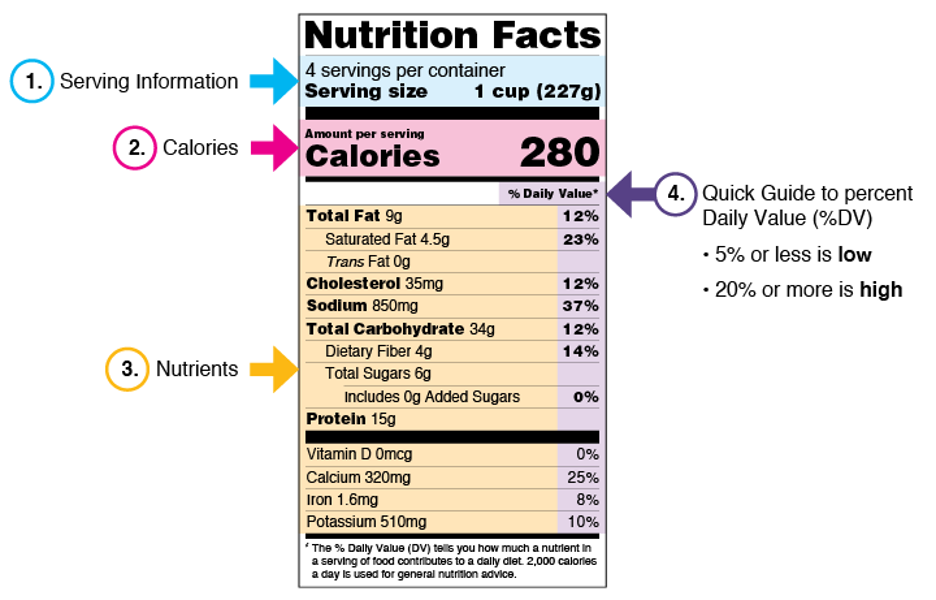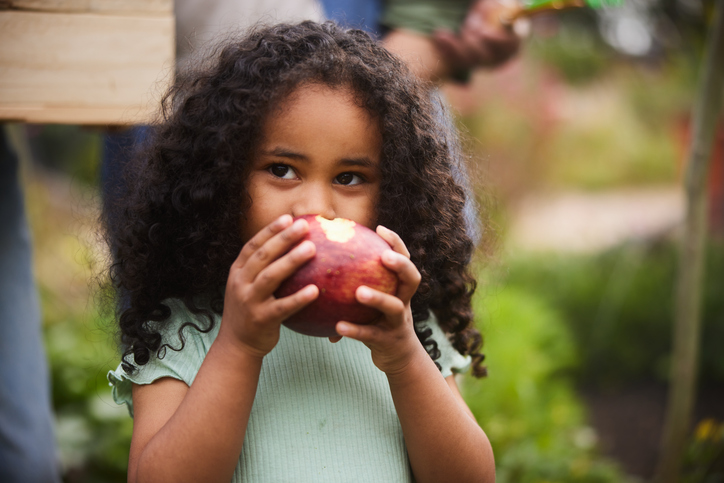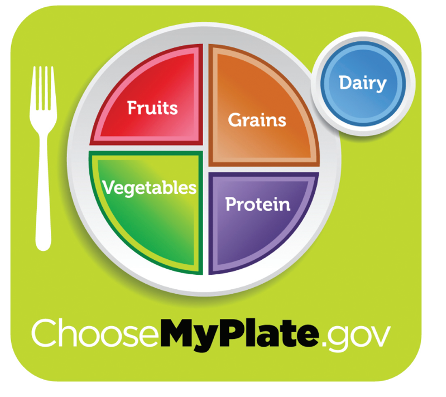Walking around the grocery store can be overwhelming with so many products lining the shelves. To add to the difficulty and confusion are Nutrition Facts food labels. What should we avoid? What should we look for in the products we buy and consume? Is the number of calories the only thing that matters? Are portion sizes misleading? What are the facts behind nutritional facts?
Where to Start with Nutrition Labels
There are four main components to a Nutrition Facts label: serving information, calories, nutrients, and percent daily value.

Serving Size
A serving size refers to the amount of food typically eaten at one time. The serving per container represents how many servings are in the respective package. This section of the label is meant to help you determine the right portion size for your family members, and it may require a little math.
For example, one serving of this food item label equals 1 cup, two servings equals 2 cups, and so on. However, by taking in two servings you’re consuming two times the calories and nutrients presented in a food label. Ultimately, the number of servings helps determine the number of calories you consume.
Calories
Calories provide a measure of how much energy you get from a serving of food. Daily caloric intake will vary for everyone, especially for growing and active children. The level of physical activity, gender, age, height, and weight all play a role.
On the food label above, if you consumed the entire package, this would equal 1,120 calories. Most labels generated on food products are based on a recommended 2,000 calorie diet.
However, caloric intake for infants, toddlers, and young children will vary and change with age compared to the number proposed for adults. Be sure to talk to your pediatrician about the total number of calories your child should consume.

Nutrients
This section holds a lot of weight, as this is where you determine which nutrients you most require in your daily diet. This will vary from item to item and maybe even day to day, including the right portion for your nutritional needs. There are also some that are recommended to avoid — like added or hidden sugars, saturated fats, and sodium.
Total sugars on a label includes the added sugars in addition to naturally occurring sugars in the food product. The two most common sources of added sugars in foods in the United States are drink products (including sodas, and sport and energy drinks) as well as snacks and sweets.
Nutrients you should aim to include in your daily diet are dietary fiber, vitamin D, calcium, potassium, and iron.
Percent Daily Value
This value shows how much of a nutrient in a serving of a specific food contributes to a total daily diet. It also helps you determine if the serving is high or low in a specific nutrient, making it easy to compare one food to another if you’re interested in incorporating high amounts of one food into your diet. Some nutrients on a nutrition label do not have a percent daily value, including trans fats and total sugars, since they are not well regulated.

Other Nutrition Label Categories to Watch
Protein
What is the most important for growing children? For infants and children, about 50% of dietary protein supports their growth, highlighting the importance of a high-protein diet. More than half of dietary protein intake is used to support growth from ages 6 months to 13 years, and just under half of dietary protein intake is used to support growth from ages 14 to 18 years. Protein rich foods include meat, poultry, fish, legumes, nuts, seeds, some dairy products, and even some whole grains and vegetables.
Fats
When it comes to fats, they must be incorporated into the diet for concentrated energy sources and assistance with the body’s metabolism. Fats should make up less than 30% of your child’s diet. Again, avoiding products that are high in saturated fats will be key to introducing healthier fats into your child’s daily diet. Healthier fats include avocado, nuts and nut butters, olive oil, fish (such as salmon and sardines), dark chocolate, chia and flax seeds, and eggs. For those youngsters that are always “grab and go” for school, breakfast may be missed. Offering a hardboiled egg with some fruit may be the ticket to stop growing bodies and brains from skipping this essential meal.

How to Use Nutrition Label Information
Overall, the goal is to be more aware of nutritional labels and the convenient nutritional facts they offer. This helps us select more nutrient dense foods as we shop — foods that are naturally lean and low in saturated fats, and have little to no added sugars, refined starches, or sodium. Also, using resources that already exist, such as MyPlate and the Dietary Guidelines for Americans can make this process easier. Read the section on more resources to learn how to incorporate these into your meal and portion planning.
Foods With No Facts
There are criteria set by the U.S. Food & Drug Administration that determine which foods are not required to have a nutrition label. Some foods that are exempt from food labeling requirements in the United States without the need for filing for registration are raw fruits, vegetables and fish. Also, foods with insignificant amounts of the nutrients on the required label, such as coffee, tea, spices, flavor extracts, and food colors. These may contain ingredient labels but are unlikely to contain nutrition facts labels.

More Resources for Nutritional Knowledge (and Action)
The Nutrients section of labels highlights what you and your family should prioritize in your daily diet (dietary fiber, vitamin D, calcium, potassium, and iron). However, these nutrients are commonly under-consumed due to inadequate intake levels through the foods we choose to eat. This is where MyPlate can help establish healthier eating patterns and provide an understanding of how to make healthier choices within each food group. This can be easily accessed online.
Fun fact: The recommended amount of dietary fiber has increased from 25% to 28% of total calories, showing its importance in healthy digestion and body weight. Most of our fiber, potassium, calcium, and vitamin D content will come from consumption of vegetables, fruits, whole grains, and dairy.
Another good resource to beef up your knowledge about nutritional facts is the 2015-2020 Dietary Guidelines for Americans. This established five guidelines for encouraging healthy eating patterns by highlighting the importance of making healthier switches across all the food groups while paying attention to calorie limits and amount of food.
Small changes like these, in conjunction with reading food labels and learning about where foods come from, will result in beneficial nutritional changes in the future for you and your family. And practice helps! The more you read labels, the easier you’ll find comparing and choosing foods based on nutritional facts.
Written by: Maria Lane, DO, a third-year pediatrics resident at Nemours Children’s Hospital, Delaware




